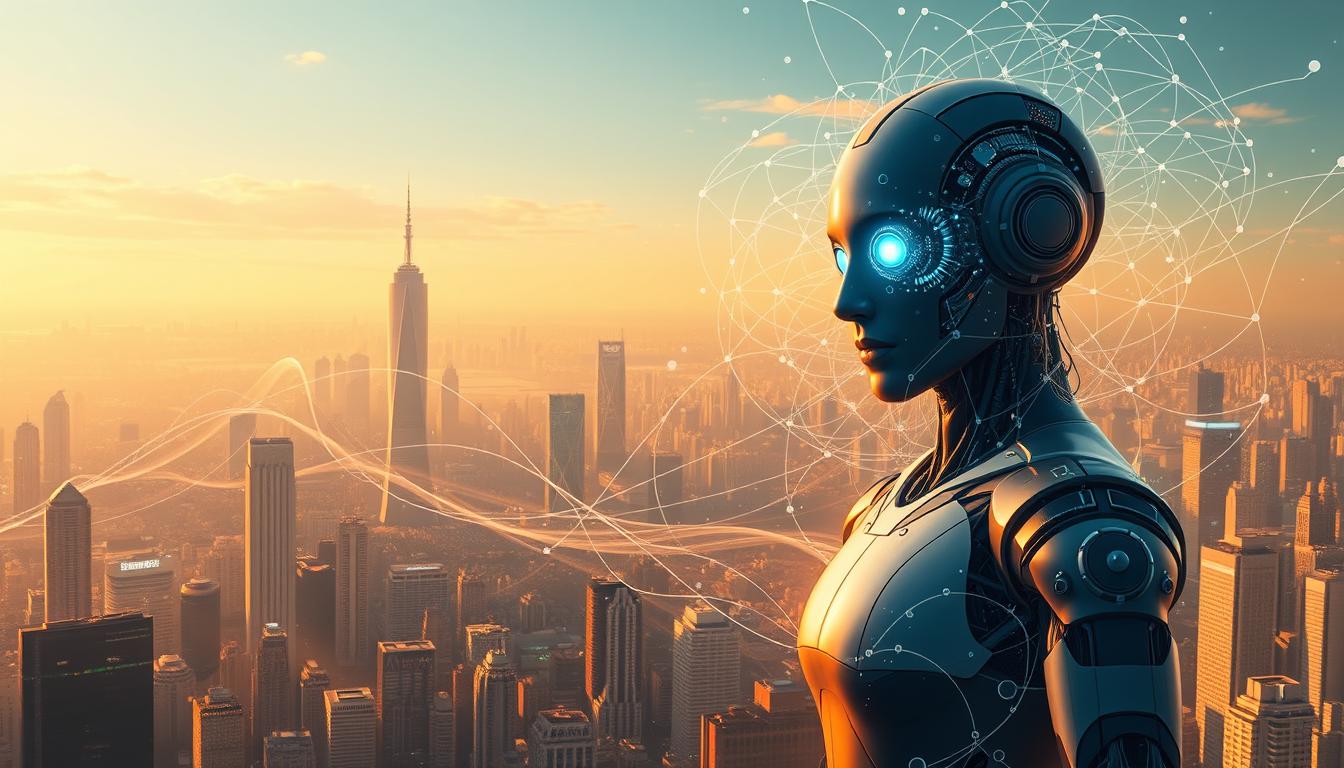
Artificial intelligence in business isn’t just promising returns—it’s delivering them with organizations seeing $3.70 for every $1 invested. This remarkable ROI explains why more than 85% of Fortune 500 companies are now using Microsoft AI solutions to shape their future.
Beyond the impressive statistics, we’re witnessing unprecedented developments in AI adoption, with implementation rates jumping from 50% to 72% in just the past year. Productivity gains are particularly notable, as 84% of Microsoft 365 Copilot users report productivity increases of 10-20%. Rather than focusing on theoretical possibilities, companies are now implementing artificial intelligence in business intelligence systems to drive decision-making with real-time insights. The global AI market reflects this shift, projected to grow from $621.19 billion in 2024 to an astounding $2.74 trillion by 2032.
In this article, we’ll explore what actually works when it comes to AI for business in 2025. We’ll examine proven implementation strategies, highlight the most impactful use cases, and show you how organizations are using artificial intelligence and business processes together to create tangible value instead of just chasing trends.
The shift from AI hype to real business value
The experimentation phase of artificial intelligence in business is ending as we enter a definitive new chapter. Companies are shifting focus from AI capabilities to measurable outcomes, moving beyond the novelty to extract genuine business value.
Why 2025 is a turning point for AI in business
The year 2025 marks a critical inflection point for AI in business, driven by several converging factors. Cost barriers are falling dramatically, democratizing access to powerful AI technologies. Companies like DeepSeek have slashed AI training costs to just a fraction of industry standards, accelerating enterprise adoption at an unprecedented pace. This reduction in infrastructure costs means businesses of all sizes can now deploy AI solutions without the financial barriers that once kept them exclusive to tech giants.
Furthermore, nearly 90% of business leaders now consider AI fundamental to their company’s strategy today or within the next two years. This widespread recognition coincides with the global AI market’s projected growth to USD 826.70 billion by 2030.
What makes 2025 different from previous years is the maturity and accessibility of AI:
- The cost of accessing PhD-level intelligence has plummeted to approximately $20 per month
- Enterprise-grade AI is now available for less than the cost of monthly software subscriptions
- AI-driven automation could contribute up to $13 trillion to the global economy by 2030
- 2025 is viewed as the tipping point for mass adoption, with the AI market expected to reach $305.90 billion, up from $150.20 billion in 2023
In contrast to previous cycles of AI development, 2025 represents not just technological advancement but economic accessibility. As one industry leader noted, “This is the worst AI will ever be. And even if all AI development stopped, we’d be busy for the next decade implementing the advantages we have today”.
From experimentation to enterprise-wide adoption
The movement from isolated AI experiments to enterprise-wide adoption represents a fundamental shift in how organizations approach artificial intelligence and business strategy. According to McKinsey, while nearly all companies are investing in AI, only 1% of leaders describe their companies as “mature” in deployment, meaning AI is fully integrated into workflows and drives substantial business outcomes.
Nevertheless, the trajectory is clear. In 2023-2024 alone, the use of generative AI jumped from 55% to 75%, signaling rapid acceleration in adoption rates. Additionally, 92% of companies plan to increase their AI investments over the next three years.
This transition is not seamless, however. Many organizations face challenges in implementation, especially in moving from pilot programs to full-scale deployment. Only 13% of companies have implemented multiple use cases, a group described as “early adopters”. Among these early adopters, 63% report their organizations’ AI strategies align significantly with their business strategies, compared to only 17% at companies still in the experimentation phase.
The key differentiator in successful implementation isn’t access to AI models – as one expert noted, “anyone with a credit card can do that”. Instead, success depends on combining those models with business data and customer insights through a robust, unified data foundation. Companies that have established solid data foundations are moving fastest with AI implementation.
Moreover, the shift extends beyond technology to organizational structure. Nearly all early adopters (91%) have implemented some governance structure for AI, compared with 77% of companies still experimenting. This governance often includes a centralized model with a dedicated center of excellence that helps align AI vision with execution.
In essence, 2025 represents the year when artificial intelligence in business moves beyond isolated testing to become integrated into the organizational DNA, delivering measurable business value that goes far beyond the hype.
AI for employee productivity and internal operations
Today’s workplaces are being reimagined as businesses harness artificial intelligence to streamline operations and boost employee effectiveness. Unlike the theoretical possibilities of yesterday, AI is now delivering tangible benefits across organizations by tackling the most tedious aspects of work.

Automating repetitive tasks and workflows
The mundane tasks that once consumed employees’ days are increasingly being handled by intelligent automation. Currently, 80% of organizations are pursuing the goal of end-to-end automation for as many business processes as possible. This shift is happening rapidly, with 92% of executives agreeing that their workflows will be digitized using AI-enabled automation by 2025.
What makes AI workflow automation distinct from previous technologies is its ability to handle complex processes without human intervention. These systems can:
- Process and analyze vast amounts of data to identify inefficiencies
- Autonomously make decisions that impact multiple business units
- Route information across departments in real-time
For example, AI can now manage entire document lifecycles—from processing invoices to analyzing contracts—functions that previously required significant manual effort. In healthcare, AI is automating administrative tasks like medical record management and appointment scheduling, freeing professionals to focus on patient care.
Enhancing decision-making with AI assistants
Beyond automation, AI assistants are becoming invaluable partners for strategic thinking and complex problem-solving. These intelligent applications understand natural language commands and use conversational interfaces to complete tasks that would otherwise require specialized knowledge or significant time investment.
The impact of these assistants on productivity is substantial. Studies show AI can improve a highly skilled worker’s performance by nearly 40% compared to those working without AI support. In practical terms, this translates to professionals writing 59% more business documents per hour and programmers completing 126% more projects per week.
What distinguishes today’s AI assistants is their context awareness—they don’t simply follow commands but interpret intent and optimize decision-making. By synthesizing vast amounts of healthcare data into coherent summaries and intuitive visualizations, AI enhances comprehension and decision-making for providers.
Reducing burnout and improving job satisfaction
Perhaps the most significant impact of artificial intelligence in business is its ability to address workplace burnout. With employees allocating almost half their workday to documentation and administrative responsibilities, AI offers a path to reclaiming meaningful work.
The evidence of AI’s positive impact on job satisfaction is compelling, with 59% of senior leaders who use AI reporting improved job satisfaction. This improvement stems from AI’s ability to handle what one expert calls “work laundry”—routine tasks like data entry or report generation that, when automated, allow employees to engage in more fulfilling activities.
AI algorithms can analyze individual work patterns and preferences to optimize workloads, preventing overburdening and ensuring employee skills are utilized effectively. Additionally, these systems can predict when an employee might be approaching burnout, enabling organizations to intervene proactively with needed support.
For Walmart’s 50,000 corporate employees, AI tools like My Assistant have eliminated the “grunt work” of formatting performance reviews, making the process 5-10 times faster. Similarly, at PwC, 95% of US employees have embraced AI tools, dedicating over 360,000 hours to finding new ways to integrate the technology into their work.
Transforming customer engagement with AI
Customer expectations have dramatically evolved, with 71% of consumers now demanding personalized interactions from businesses. As a response, companies are leveraging artificial intelligence in business to transform how they engage with their audiences.
Personalized experiences at scale
Gone are the days of generic marketing campaigns. Today, artificial intelligence and business data converge to create deeply individualized experiences that connect with customers on a personal level. AI analyzes extensive information from browsing histories, purchase records, and social media to identify unique user patterns, creating hyper-personalized customer journeys that evolve in real-time.
The results speak for themselves. Personalized email subject lines are 26% more likely to be opened, with segmented campaigns generating a remarkable a 760% increase in email revenue. Furthermore, 77% of consumers choose, recommend, or pay more for brands that deliver personalized experiences.
What distinguishes today’s AI personalization is its ability to predict and adapt to user behaviors instantly. Rather than simply categorizing customers into segments, AI enables one-to-one personalization, crafting individualized messaging that resonates with each customer’s current needs.
AI-powered customer support and chatbots
Customer service has undergone a fundamental transformation through AI-powered chatbots that simulate human conversation while providing instant, 24/7 support. These advanced systems now connect to backend databases, accessing purchase history and account details to deliver contextually relevant assistance.
The operational benefits are substantial. AI chatbots handle over 80% of customer issues independently, simultaneously reducing support costs by up to 30% while improving satisfaction metrics. One cosmetics brand saved approximately 5 minutes per support ticket and 360 agent hours monthly after implementing AI agents.
Beyond efficiency gains, modern AI assistants build deeper emotional connections with customers through:
- Immediate, multilingual support regardless of time zones
- Personalized recommendations based on individual preferences
- Proactive resolution of potential issues before they escalate
Faster content creation and campaign execution
Artificial intelligence in business intelligence is revolutionizing how marketing teams develop and execute campaigns. Currently, 73% of U.S. marketers have adopted generative AI tools for content creation, automating everything from social media posts to email campaigns.
AI systems analyze performance data across creative assets, identifying which elements drive engagement. This intelligence allows brands to produce more relevant content efficiently, with development time reduced by 75% in some cases. Additionally, AI enables marketers to rapidly test these creative templates at scale, continuously refining recommendations based on performance analytics.
In 2025, the most successful organizations use AI not just for automation but to fundamentally reimagine customer relationships through personalization that feels genuinely human.
AI in business processes and operations
Beyond customer-facing applications, artificial intelligence in business is reshaping core operational functions across enterprises. Companies implementing AI-powered supply chain management software report 15% lower logistics costs and 35% improved inventory levels compared to competitors.
Optimizing supply chains and logistics
Supply chain optimization through AI focuses on generating more accurate ETAs and identifying at-risk shipments. Currently, trucking in the U.S. runs at approximately 30% empty capacity, wasting fuel and increasing carbon emissions. Through AI-optimized routing, companies have reduced these empty miles to between 10-15%, consequently decreasing environmental impact and operating costs.
Warehouse operations benefit substantially from AI implementation. Machine learning models evaluate inventory movement patterns to suggest optimal floor layouts, speeding fulfillment rates. Additionally, AI analyzes historical demand data to balance inventory against carrying costs, minimizing both stockouts and surplus inventory.
AI in finance, HR, and compliance
Finance departments traditionally handle numerous repetitive, manual tasks that are ideal targets for AI automation. Organizations using AI for financial processes close their books in half the time of competitors, freeing teams to focus on analysis rather than data processing.
In the HR realm, 83% of millennials and 79% of Gen Z respondents indicated they would trust a robot over their organization’s finance team. Hence, modernizing these functions has become essential for talent attraction. AI enhances HR operations through:
- Automated resume screening and candidate matching
- Employee retention analysis comparing salary and turnover against industry averages
- Contextual guidance for technical support via AI-trained systems
Low-code/no-code AI for internal tools
Developers typically spend over 30% of their time building internal applications. Low-code/no-code AI platforms have emerged as solutions that enable non-technical users to create sophisticated AI applications through intuitive interfaces.
These platforms feature drag-and-drop functionality and pre-built templates, allowing users to construct AI models without coding knowledge. By leveraging these tools, businesses can develop critical internal applications in minutes rather than months, ultimately clearing backlogs faster and reducing development costs by more than 50%.
Driving innovation and competitive advantage
Beyond operational efficiencies, artificial intelligence in business has become a catalyst for innovation, creating substantial competitive advantages for early adopters. Companies with strong innovation cultures are positioning themselves at the forefront of AI development, gaining measurable market advantages through accelerated development cycles and novel business models.
Accelerating product development
Generative AI is significantly reducing product development timelines. Studies show that AI tools accelerate product time to market by approximately 5% across a six-month development lifecycle. Product managers using AI report a remarkable 40% boost in productivity, with content-heavy tasks showing nearly twice the productivity gains compared to simpler functions. Notably, 100% of participants in one study reported improved work experiences when using AI tools.
In practical applications, AI enables teams to rapidly synthesize user research, develop requirement documents, and create product backlogs more efficiently. This acceleration allows companies to shift resources toward more strategic activities such as defining product vision and conducting customer-facing initiatives.
Creating new business models with generative AI
Organizations implementing AI-driven business models are 1.5 times more likely to experience considerable revenue growth compared to competitors. Presently, three primary business models are emerging around generative AI:
- Model-as-a-Service (MaaS), offering subscription-based access to AI capabilities
- Built-in apps that leverage generative AI for specialized experiences
- Vertical integration that enhances existing products with AI capabilities
These models enable companies to monetize AI through recurring revenue streams while providing customers with tailored solutions that address specific business challenges.
Examples of AI-led innovation in 2025
By 2025, AI-powered agents will handle increasingly complex assignments with enhanced memory, reasoning, and multimodal capabilities. These agents autonomously execute sales orders, alert supply chain managers about disruptions, and recommend new suppliers without human intervention.
In scientific research, AI is driving breakthroughs in biomolecular science, enabling unprecedented speed in drug discovery. Additionally, AI reasoning capabilities are transforming industries like biotechnology, clinical trials, and law, where outputs have increased tenfold through strategic AI implementation.
Ultimately, businesses integrating AI into their innovation processes are establishing lasting competitive advantages through faster product cycles, improved quality, and entirely new business possibilities.
Throughout this exploration of artificial intelligence in business, we’ve seen a clear shift from theoretical possibilities to practical realities. Companies now observe tangible returns on their AI investments—$3.70 for every dollar spent. This remarkable ROI undoubtedly explains why 85% of Fortune 500 companies have embraced Microsoft AI solutions.
The year 2025 stands as a decisive turning point for AI adoption. Cost barriers have fallen dramatically, democratizing access to powerful AI technologies while implementation rates have jumped from 50% to 72% in just the past year. Though many organizations continue their journey from isolated experiments to full enterprise integration, early adopters already report significant alignment between their AI strategies and business objectives.
Beyond productivity gains, AI has transformed how businesses engage with customers. Personalized experiences, 24/7 AI-powered support, and efficient content creation have become standard practices rather than aspirational goals. Additionally, core operational functions like supply chain management, finance, and HR have undergone fundamental improvements through intelligent automation.
Perhaps most significantly, artificial intelligence has become a catalyst for innovation. Companies implementing AI-driven business models are 1.5 times more likely to experience considerable revenue growth compared to competitors. Meanwhile, product development cycles accelerate as AI tools boost productivity across development teams.
After examining what actually works with AI in 2025, one conclusion stands above all others: successful organizations don’t chase AI trends—they systematically apply artificial intelligence to solve specific business problems. The future belongs to companies that view AI not as a separate initiative but as an integrated capability woven into every aspect of their operations.
FAQs
Q1. How will AI impact businesses by 2025? By 2025, AI is expected to significantly enhance business operations through improved automation, personalized customer experiences, and accelerated product development. Companies implementing AI-driven strategies are likely to see increased productivity, cost savings, and new revenue streams from innovative business models.
Q2. What are the key areas where AI is transforming business operations? AI is transforming business operations in several key areas, including employee productivity, customer engagement, supply chain optimization, and financial processes. It’s automating repetitive tasks, enhancing decision-making with AI assistants, and enabling personalized customer experiences at scale.
Q3. How is AI improving employee productivity and job satisfaction? AI is boosting employee productivity by automating routine tasks, allowing workers to focus on more strategic and fulfilling activities. This shift is leading to improved job satisfaction, with many employees reporting reduced burnout and more meaningful work experiences when using AI tools.
Q4. What role does AI play in customer engagement? AI is revolutionizing customer engagement through personalized experiences, AI-powered customer support, and faster content creation. It enables businesses to deliver tailored interactions, provide 24/7 support via chatbots, and create more relevant marketing campaigns efficiently. Q5. How are businesses using AI to drive innovation? Businesses are leveraging AI to accelerate product development cycles, create new AI-driven business models, and explore groundbreaking applications in fields like scientific research and biotechnology. This is allowing companies to bring products to market faster, generate new revenue streams, and establish competitive advantages in their industries.






Great insights on AI’s influence-thanks for highlighting how platforms like AI Translation make cutting-edge tools accessible and practical for everyday use.